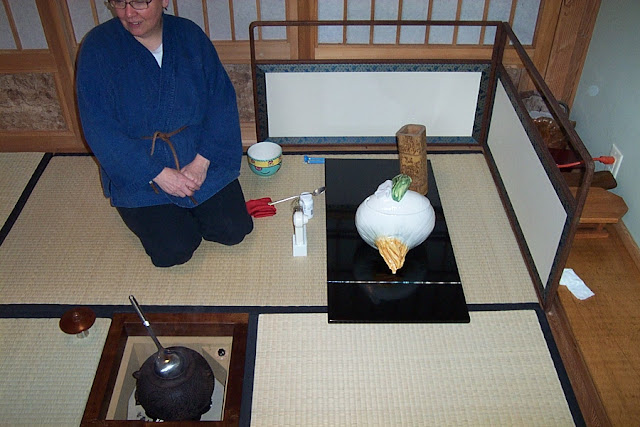"One learns by looking and studying. Without understanding completely, one cannot criticize." ~ from the 100 poems of Rikyu
We just had an intensive workshop here in Portland with Christy-sensei. It is always inspiring and somewhat intimidating. The format is one after another, students make tea for sensei and we often go from the very beginning procedures to the very highest in the space of about 3 days. Or maybe in the reverse order, depending on the schedule. We all were studying our notes before she arrived, and sitting seiza at night watching TV to build up our strength for those 12 hour days sitting seiza.
We always have warigeiko, that is, back to the basics of folding the fukusa and purifying the utensils. I always learn so much from this, even though I have been doing tea for many years. Christy said that when the Gyotei came to San Francisco and he was teaching warigeiko, all he did was talk about posture. Those finer points, points I knew and have forgotten, or have gotten sloppy at wore gone over and I retrained my body again. Christy is so very good at giving honest feedback on form. That is also why tea cannot be learned from a book or by yourself with videos. You need a teacher who can look at you and correct your form, placement, posture, and speed. You need a teacher who will tell you to stop and take a breath. A teacher will also tell you straighten your back or keep your focus on your non-working hand.
When I was in Japan, some teachers didn't teach as actively as teachers here in America. One only watched you as you went through your temae and said not a word. If you forgot or got lost, he just looked at you and it was up to you to struggle through to the end. Another one would tell me that I was not doing it right, but did not tell me how to correct it, I had to figure it out. Boy those were some hard lessons, and yes, I do remember them much more vividly than if the teacher had just prompted and corrected me at the time.
I had a teacher who once said that the presence of the teacher is more important than the teaching itself. If a student really wanted to learn the way of tea, they had to steal the knowledge. By watching and paying attention was how one learned.
In America, sometimes students will question the teacher, especially if they have had other teachers in how to do a procedure. (or more recently saw something on video or Youtube) My sempai taught me (rather severely) that whoever is teaching at the time is the right way to do it. I have note books with notations (Christy sensei teaches this way, but Minako sensei teaches this way). Even if the same teacher teaches something a little differently at a different time, it is still correct at the time the sensei is teaching.
This is very hard for some people to grasp. If there is a right way to do it, they want to know it and they want to know it will always be consistently right. In Chado there is a right way to do things and we must learn it. But there will always be some ambiguity in oral teaching and we must make the best of it as we can. When we have the experience and understanding to judge, we can decide what is right for us. Until then, the sensei teaching at the time is always right. Just say "hai."














